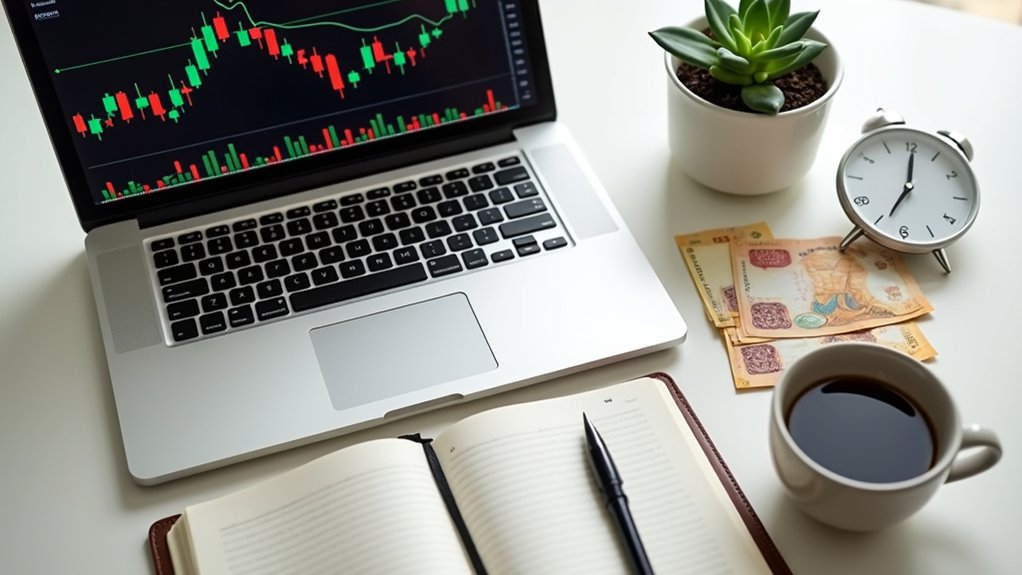Forex currency pairs show the exchange rate between two national currencies, and they're the backbone of the world's biggest financial market. Seven major pairs—always featuring the US dollar—dominate trading and account for roughly 75% of all forex transactions worldwide. EUR/USD leads the pack as the most traded pair, while others like GBP/USD (nicknamed “Cable”) bring serious volatility to the table. Then there are cross pairs without the dollar and exotic pairs pairing majors with emerging market currencies. Economic indicators, interest rates, political chaos, and central bank decisions move these pairs daily—and understanding the distinctions reveals what drives global currency movements.

Understanding Forex Currency Pairs
Major forex currency pairs are the most traded pairs in the global market, and they almost always involve the US dollar. That's the rule. EUR/USD, USD/JPY, GBP/USD, USD/CHF, AUD/USD, USD/CAD, NZD/USD. These seven pairs dominate the landscape. They account for about 75% of all forex trades worldwide.
Seven major pairs, all tied to the US dollar, control three-quarters of the entire global forex market.
For African traders sitting in Lagos, Nairobi, or Johannesburg, these are the pairs most brokers will push. High liquidity. Tighter spreads. More predictable movements, supposedly.
The EUR/USD pair is the heavyweight champion. Most traded in the world. It reflects global economic health, which matters when you're trading from Ghana or Egypt and trying to read what Europe's economy means for your position. USD/JPY gets attention because of interest rate differences between the US and Japan. It's considered a safe-haven pair. GBP/USD, nicknamed “Cable,” is volatile. Brexit proved that. UK political drama translates directly into price swings. USD/CHF features the Swiss Franc, another safe-haven currency that traders in Morocco or South Africa might watch during global uncertainty.
Then there are the commodity pairs: AUD/USD, USD/CAD, NZD/USD. Commodity prices drive these. For African traders in resource-rich countries like Angola, Zambia, or Botswana, understanding how commodity markets influence currency pairs is critical. Oil prices affect USD/CAD. Metal prices shift AUD/USD. It's all connected.
Cross currency pairs don't involve the US dollar. GBP/EUR, EUR/CHF, EUR/JPY. They're less traded but still relevant. Some have nicknames. GBP/EUR is called “Chunnel.” These pairs can reflect regional economic dynamics without American influence, which might appeal to traders in Tunisia or Kenya looking to diversify away from dollar exposure. Beyond crosses, exotic currency pairs match major currencies with those from emerging or smaller economies, offering unique opportunities despite wider spreads and lower liquidity.
What moves these pairs? Economic indicators like GDP growth, inflation, interest rates. Political events. Central bank policies. Global crises. When the South African Reserve Bank shifts policy, it might not move EUR/USD much, but it matters locally. When the European Central Bank makes moves, it ripples everywhere, including across African trading desks.
Major pairs serve as economic barometers. They reflect trade balances, investment flows, and financial stability. Some African countries hold USD reserves, which ties directly into forex market dynamics. The Nigerian naira, the Kenyan shilling, the Egyptian pound—all dance around these major pairs because the dollar dominates. That's the reality. African traders navigate a market built on currencies far from home, trying to profit from movements shaped by economies that often ignore the continent entirely. Understanding the key market differences between forex and stock trading helps traders choose which financial market better suits their strategy and risk tolerance. Traders pursuing rapid scalping strategies often gravitate toward these major pairs because their high liquidity enables quick entry and exit from positions. Behind every price movement are central banks, commercial banks, institutional investors, and retail traders who collectively drive the currency trading activity that determines exchange rates.
Common Questions
Which African Currency Pairs Have the Lowest Spreads With Local Brokers?
USD/ZAR dominates with spreads as low as 8–30 pips through South African brokers—easily the tightest among African pairs.
EUR/ZAR follows at 23 pips minimum. Nigeria's USD/NGN sits around 35 pips, while Kenya's USD/KES hits 40 pips and Egypt's USD/EGP goes above 35 pips.
The Rand pairs win because Johannesburg's trading volume crushes competitors.
Everything else? Way wider spreads, thanks to thin liquidity across most African currencies.
Can I Trade Exotic Pairs Involving Naira or Cedi Profitably in Africa?
Trading Naira or Cedi exotics can be profitable—if traders survive the harsh realities first.
High volatility creates big moves, perfect for event-driven plays around Nigerian elections or Ghana rate decisions. But liquidity is terrible, spreads are punishingly wide, and most African brokers don't even offer direct NGN/GHS pairs.
Currency controls in Nigeria strangle access. Transaction costs eat profits fast. Fundamental analysis and minimal leverage (2:1 max) are non-negotiable.
It's possible, just brutally expensive.
Do African Brokers Offer Better Rates for Intra-African Currency Pairs?
Most African brokers don't offer better rates for intra-African pairs—they usually provide worse spreads. These pairs involve illiquid currencies like the naira or cedi, which means wider spreads and higher costs.
Brokers prioritize major pairs like EUR/USD where demand is higher and liquidity stronger. South African brokers under FSCA regulation might offer some regional pairs, but even then, the spreads aren't competitive.
Lower liquidity across African currencies makes profitable trading harder. The economics just don't favor local pairs.
Why Are Some African Currencies Unavailable for Trading With Certain Brokers?
Most African currencies simply don't make the cut. Regulators in places like Nigeria, Egypt, or Zimbabwe tightly control forex flows—brokers can't touch them without running into legal walls.
Low liquidity is another killer. Thin markets mean wild swings and fat spreads, which brokers hate.
Add compliance headaches—AML rules, KYC chaos, fraud risks—and it's easier to skip the whole mess.
Economic instability and currency volatility seal the deal. Brokers stick to safer, liquid pairs instead.
How Does Capital Control in My Country Affect Which Pairs I Can Trade?
Capital controls in a trader's country directly restrict which pairs are legal to trade.
Some African governments require approval or quotas for accessing USD, EUR, or GBP, making those pairs harder—or impossible—to trade freely. Others enforce dual exchange rates or ban offshore trading entirely.
The result? Fewer pairs available, higher costs, wider spreads, and sometimes outright prohibitions on certain crosses. Traders can't just pick any pair; the government decides what's allowed.










